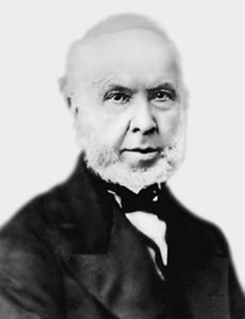Related Research Articles
The Lucasian Chair of Mathematics is a mathematics professorship in the University of Cambridge, England; its holder is known as the Lucasian Professor. The post was founded in 1663 by Henry Lucas, who was Cambridge University's Member of Parliament in 1639–1640, and it was officially established by King Charles II on 18 January 1664. It was described by The Daily Telegraph as one of the most prestigious academic posts in the world and its former holders include Isaac Newton, Charles Babbage, George Stokes, Joseph Larmor, Paul Dirac and Stephen Hawking.

William Cavendish, 7th Duke of Devonshire,, styled as Lord Cavendish of Keighley between 1831 and 1834 and known as the Earl of Burlington between 1834 and 1858, was a British landowner, benefactor, nobleman, and politician.

Peter Guthrie Tait FRSE was a Scottish mathematical physicist and early pioneer in thermodynamics. He is best known for the mathematical physics textbook Treatise on Natural Philosophy, which he co-wrote with Kelvin, and his early investigations into knot theory.
The Sadleirian Professorship of Pure Mathematics, originally spelled in the statutes and for the first two professors as Sadlerian, is a professorship in pure mathematics within the DPMMS at the University of Cambridge. It was founded on a bequest from Lady Mary Sadleir for lectureships "for the full and clear explication and teaching that part of mathematical knowledge commonly called algebra". She died in 1706 and lectures began in 1710 but eventually these failed to attract undergraduates. In 1860 the foundation was used to establish the professorship. On 10 June 1863 Arthur Cayley was elected with the statutory duty "to explain and teach the principles of pure mathematics, and to apply himself to the advancement of that science." The stipend attached to the professorship was modest although it improved in the course of subsequent legislation.

Robert Jameson FRS FRSE was a Scottish naturalist and mineralogist.
The Regius Professorship of Greek is one of the oldest professorships at the University of Cambridge. The Regius Professor chair was founded in 1540 by Henry VIII with a stipend of £40 per year, subsequently increased in 1848 by a canonry of Ely Cathedral.

Edward Daniel Clarke was an English clergyman, naturalist, mineralogist, and traveller.

Prof William Hallowes Miller FRS HFRSE LLD DCL was a Welsh mineralogist and laid the foundations of modern crystallography.
Josef (Joseph) August Schultes was an Austrian botanist and professor from Vienna. Together with Johann Jacob Roemer (1763–1819), he published the 16th edition of Linnaeus' Systema Vegetabilium. In 1821, he was elected a foreign member of the Royal Swedish Academy of Sciences. He was the father of Julius Hermann Schultes (1804-1840).

Victor Moritz Goldschmidt was a Norwegian mineralogist considered to be the founder of modern geochemistry and crystal chemistry, developer of the Goldschmidt Classification of elements.

François Sulpice Beudant, was a French mineralogist and geologist. The mineral beudantite was named after him.

Henry Darwin RogersFRS FRSE LLD was an American geologist. His book, The Geology of Pennsylvania: A Government Survey (1858), was regarded as one of the most important publications on American geology issued up to that point.
Prof Cecil Edgar Tilley FRS HFRSE PGS was an Australian-British petrologist and geologist.

Samuel Hooper was a businessman and member of Congress from Massachusetts.
Ekhard Karl Hermann Salje, FRS is Professor of Mineralogy and Petrology and former Head of the Department of Earth Sciences, Cambridge University.
The Wernerian Natural History Society, commonly abbreviated as the Wernerian Society, was a learned society interested in the broad field of natural history, and saw papers presented on various topics such as mineralogy, plants, insects, and scholarly expeditions. The Society was an offshoot of the Royal Society of Edinburgh, and from its beginnings it was a rather elite organization.
Hans Schneiderhöhn was a German geologist and mineralogist who specialized in ore microscopy.

Edward Pearson (1756–1811) was an English academic and theologian, Master of Sidney Sussex College, Cambridge from 1808.

Geoffrey Michael Gadd is a British-Irish microbiologist and mycologist specializing in geomicrobiology, geomycology, and bioremediation. He is currently a Professor at the University of Dundee, holding the Boyd Baxter Chair of Biology, and is head of the Geomicrobiology Group.
References
- ↑ "Professors". Cambridge University. Retrieved 5 April 2019.